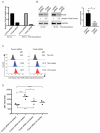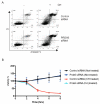Regulation of Oxidative Stress in Corneal Endothelial Cells by Prdx6
- PMID: 30518072
- PMCID: PMC6316742
- DOI: 10.3390/antiox7120180
Regulation of Oxidative Stress in Corneal Endothelial Cells by Prdx6
Abstract
The inner layer of the cornea, the corneal endothelium, is post-mitotic and unable to regenerate if damaged. The corneal endothelium is one of the most transplanted tissues in the body. Fuchs' endothelial corneal dystrophy (FECD) is the leading indication for corneal endothelial transplantation. FECD is thought to be an age-dependent disorder, with a major component related to oxidative stress. Prdx6 is an antioxidant with particular affinity for repairing peroxidised cell membranes. To address the role of Prdx6 in corneal endothelial cells, we used a combination of biochemical and functional studies. Our data reveal that Prdx6 is expressed at unusually high levels at the plasma membrane of corneal endothelial cells. RNAi-mediated knockdown of Prdx6 revealed a role for Prdx6 in lipid peroxidation. Furthermore, following induction of oxidative stress with menadione, Prdx6-deficient cells had defective mitochondrial membrane potential and were more sensitive to cell death. These data reveal that Prdx6 is compartmentalised in corneal endothelial cells and has multiple functions to preserve cellular integrity.
Keywords: Fuchs’ endothelial corneal dystrophy; Prdx6; cornea; lipid peroxidation; mitochondrial membrane potential.
Conflict of interest statement
The authors declare that they have no competing interests. The funders had no role in study design, data collection and analysis, decision to publish, or preparation of the manuscript.
Figures





References
Grants and funding
LinkOut - more resources
Full Text Sources
Miscellaneous

